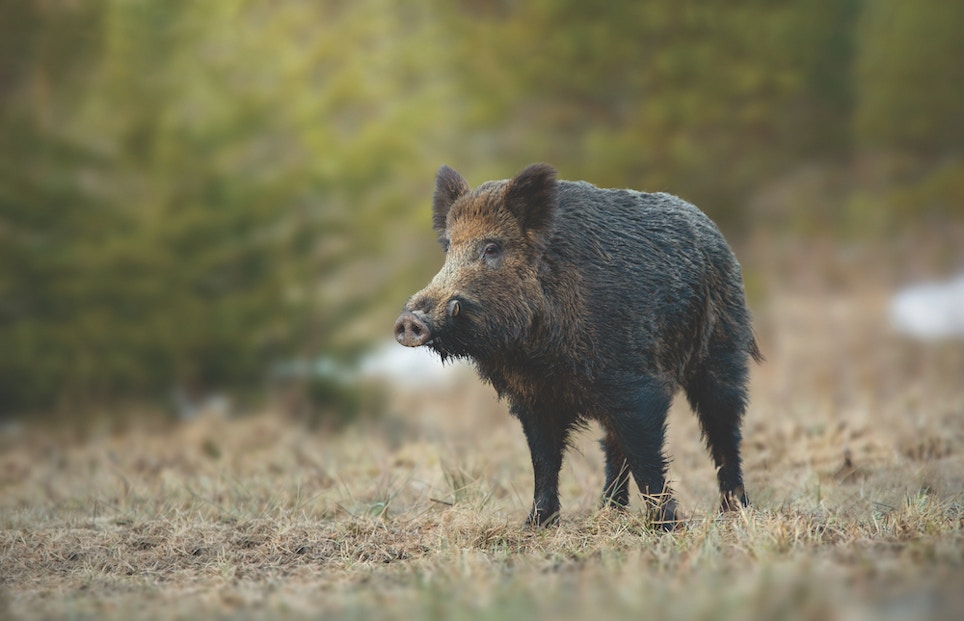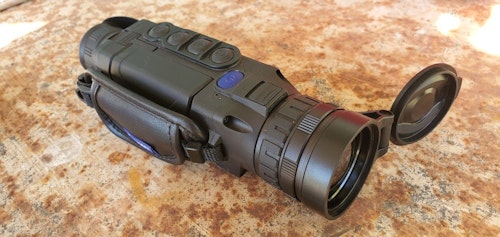It’s a common theme in the hog-hunting world — believing you can only successfully chase feral hogs during the dark of night. There are certainly pros to hunting the midnight hours, but this is not the only time these porcine critters are out and about. Hunting hogs during daylight hours is not only an option, it can be productive. You want as many usable hunting hours as possible, right? Here’s what you need to know about hog hunting under the moon — and under the sun.
My first hog hunt took place in the early morning daylight, sitting in a ground blind strangely positioned on the side of a hill with the only shooting lanes being uphill. I was armed with a Remington R25, the air was crisp and I was excited. A couple hours passed before a boar wandered by, and a Hornady Full Boar .308 Win. 165-grain GMX bullet through the heart ended the drama — over and done in a moment.
What I didn’t know then was that there are myriad ways to hunt hogs when the sun is shining and some are more awesome than others, especially for those of us who admit to being adrenaline junkies. If ground blinds are your preference, more power to you. Nothing wrong with it. But if you’d like to try something different consider spot-and-stalk hunting, taking long-range shots or even shooting from a vehicle, if the latter is legal in your state.
Spotting and Stalking Hogs
A spot-and-stalk hunt is a solid way to get a jump on wild hogs, whether you do it first thing in the morning or later in the day. During the early morning hours or the hours prior to dusk, when the air is cooler, you’re most likely to find them moving around scavenging for food. At midday, when temperatures rise enough to make things uncomfortable for them, hogs can be found resting in the shade or hanging out at their favorite local watering hole.
The key to a successful spot-and-stalk hunt is remembering to move silently and pay attention to wind direction. Hogs might not have the keenest eyesight, but they’ll hear and smell you coming. Of course, it also helps to have at least a rough idea of where they’ll be at any given time during the day. Scouting can be your best friend.
Stretching the Barrel
Whether long-range shooting at live game is a moral debate that can cause some interesting divides among hunters. Personally, I believe we as hunters are required to make ethical shots and one-shot kills. If you aren’t confident that your long-range shooting skills are such that you can make a lethal long-distance shot on a hog, don’t do it. Just because they’re an invasive species doesn’t mean they shouldn’t die quickly and cleanly. Make sure you are up to the task before taking long-range shots at live targets.
Choose a spot with a good vantage point and take the time to range the distance to several landmarks in your field of view. If you’re hunting in a state where baiting is allowed, use said bait as your farthest shot location. Then you can either take a hog that’s walking to the feed or a stationary shot as it eats.
This also requires that you are familiar with the drift and drop of the ammo you’re shooting as well as knowing what it is and is not capable of handling in regard to terminal performance. Making a shot on paper or steel at 500, 750 or 1,000 yards isn’t the same as shooting an animal at those distances. Make sure your rifle, optics and ammo are up to the task. When I’m lying prone waiting for a long-range shot — think 750 to 1,000 yards — the powerhouse .338 Lapua Mag. is a favorite.
Drive-by Hog Hunting
It’s up to the individual state fish and game agencies to determine if it’s legal to hunt from a vehicle. Here in Texas, we basically do what we want when we’re gunning for feral hogs. If it’s legal where you hunt, be sure you pay attention to such details as height over bore and moving targets. It puts a damper on the day if you accidentally blow a hole in the truck because you didn’t realize your scope height over the rifle’s bore meant the bullet would dig through the hood or take out a side mirror. Check your muzzle clearance before taking the shot.
Guns and gear for daylight hours tend to be more affordable than what you need for nighttime hunting. Any rifle, shotgun or handgun — this is where I remind you to know your local laws — in a large enough caliber will suffice. Sighting solutions are personal preference, with scopes and red-dot, laser or iron sights all good bets. If you’re setting up for long-range shooting, you’re going to need a high-power, high-quality scope (and a larger-bore rifle with a good bipod).
Spare magazines are a must when after hogs, as is a sufficient amount of ammunition. Extras such as binoculars and rangefinders depend on the area you’re hunting and at what distance you intend to shoot. As for camo, you’re not duty-bound to camo up from head to toe. Stop and think about the area you’re hunting and dress accordingly to break up your outline and increase your odds for success. You will need better concealment during the day than at night, but hogs don’t possess the eyesight of turkeys so there’s no need to go overboard.
What do the pros say? Long-time hunting manager Dusty Stevens says he enjoys daylight hours because he enjoys how you can spot the hogs from a greater distance and alter your movements as needed. “It also gives you time to decide on distance and point of aim vs. point of impact with your gun,” he said. “If you’re long-range shooting you’ll have time to adjust your scope. Depends on what you as a hunter want, but I like hunting both during the day and at night.”
Nightwalkers
Hunting at night means worrying less about what you’re wearing. I’m not saying you should go sprinting through a field in bedazzled blaze orange while waving sparklers over your head, but it’s perfectly acceptable to throw on jeans and a dark jacket and call it good. Pros to hunting at night include the cool air being friendlier to large sounders of hogs moving around, visualizing the hogs by their heat signature before they see you and using the cover of darkness to your advantage for stealthy movement.
Yes, night hunting rocks. It’s an experience unlike any other and provides the opportunity to use equipment you might not otherwise get to put into your hunting rotation. And here’s a secret: You don’t have to invest in high-end thermal optics to kill hogs after dark. It makes life easier and adds an element of Secret Agent Hunter to the experience but isn’t a must-have.
One way to bypass the expense of thermal and night vision optics is by using green lights which, due to the hog’s visual spectrum, are less noticeable than white or red lights. Wildgame Innovations’ Moonshine Light is a motion-activated green light that mounts to your feeder and has an integrated solar panel to keep it charged. It has 16 LEDs, an on-off switch and universal mounting hardware — a solid option if you’re using a feeder. If you prefer mounting a light to your firearm, check out Streamlight’s Night Vision Tactical Hunting Gun Light with green LED lighting. It produces 150 lumens, mounts to any Mil-Std 1913 Picatinny and Glock-style rails and runs on a pair of CR123A lithium batteries. A remote switch is included for greater accessibility.
As for thermal optics, Pulsar is a stellar choice for wild hog hunters. And when using thermal optics you aren’t limited to scope-only models, either. Pulsar’s Helion 2 XP is a thermal monocular perfect for scanning fields at night. It has an NETD <40 mK sensor for clearer images, variable digital zoom up to 8X and a built-in video recorder.
As for thermal scopes the Pulsar Trail 2 LFR is an excellent model designed to operate in rain, fog and cold with features such as high-definition imaging, a built-in laser rangefinder and shockproof magnesium alloy housing. And like the company’s monocular, the Trail 2 LRF also has video recording built into it. Both models are powered by external battery packs that ship with the scopes and can be charged through a USB power source.
Unlike thermal, reads heat signatures, night-vision optics collect ambient light. Higher-quality Gen 2 or 3 night vision options offer fantastic clarity and good range. Be aware that staring through night vision optics for lengthy stretches can give you a headache — been there, done that — so take frequent breaks from looking through NV goggles or scopes.
The Bushnell Z2 night vision 6x50mm monocular allows you to see potential targets 1,000 feet away during daylight and nighttime hours thanks to its being a digital night vision platform. It has a built-in infrared illuminator, is WiFi capable and can be used to record video.
On the night vision scope side, the Pulsar Digex N450 digital riflescope offers a 600-yard detection range, 4X zoom and Stream Vision app so you can connect your riflescope to your smart phone. Technology might have its downsides but the ability to connect my thermal and night vision optics to my smartphone for remote viewing is a pretty epic advancement.
High Plains Hunts owner Jeremy Simpson night hunts exclusively. Why? “Because hogs are some of the smartest game that can be hunted, with their eyes and ears being comparable to humans, and their noses being some of the best in the world,” he explained. “I hunt at night to stack every odd I can in my favor.”
The bottom line is this: Hunt hogs whenever possible. If that means you’re hitting wheat fields at night decked out in thermal gear, great. If you’re lying prone looking for a long-range daytime shot over bait, excellent. Do what works for you and take care not to dismiss other hunters’ methodology. My feelings on the issue fall somewhere under the “you do you” heading. Get out and hunt hogs — anytime of the day or night.









